Apple Mac Pro (Mid 2010) Review
by Anand Lal Shimpi on October 6, 2010 9:26 PM ESTPerformance
The new Mac Pro is fast, but then again so was the old one. Earlier this year I tried using the 15-inch Core i7 MacBook Pro as my notebook and desktop - my experiment lasted all of a day, I missed the performance. It’s not so much an issue of peak performance, but one of core count and noise. While I rarely run applications that demand four (or more) cores, running a lot of applications that each eat 5 - 25% of a single core at the same time adds up. I also found that confined to a relatively thin notebook fans spun faster under typical CPU loads for me, as a result the overall system produced more noise than a larger tower.
I’ve got three Mac Pros represented in the charts below. The original late 2006 Mac Pro but upgraded to two 3.0GHz quad-core CPUs (effectively making it an early 2008 Mac Pro), the early 2009 Nehalem based Mac Pro once again upgraded to a pair of 2.93GHz quad-core CPUs and of course the new 2010 Mac Pro in its default eight-core configuration (2 x 2.4GHz quad-core CPUs).
Westmere only brought mild IPC improvements, so it shouldn’t really offer any tangible performance advantage over last year’s model. The only benefits will really be power, but let’s go down the list to put things in perspective.
Cinebench R10 & 11.5
Most applications won’t stress the 16 threads you get in the eight-core Mac Pro with the exception of offline 3D rendering of course. We’ll start out with Cinebench R10:
The single threaded shows how far we’ve come in single threaded performance just comparing Conroe to Nehalem. At roughly the same clock speed the 2009 Mac Pro manages a 25% performance improvement over the 2008 Mac Pro. Part of the advantage is obviously due to single threaded turbo mode, but it’s an advantage nonetheless. If you have a higher clocked Nehalem Mac Pro you’ll need to upgrade to something at least as fast as what you have now, the 2.4GHz default clock of the eight core system is simply too low to offer any advantage over the higher clocked alternatives in this chart.
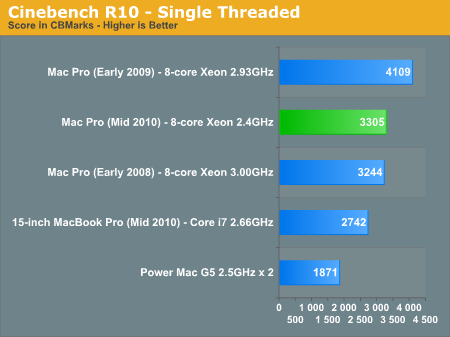
I also threw in the dual processor Power Mac G5 2.5GHz to put things in perspective. While a highly configured Mac Pro from 2008 may not be in need of an upgrade, if you’re still doing work on a Power Mac G5 an upgrade would be very appreciated. Westmere is 76% faster than the 2.5GHz G5 in this single threaded test.
Multithreaded performance scales very well on Nehalem and Westmere as you can see below:

The key takeaway here is that if you had a high clocked, eight-core Mac Pro from 2008 you can’t get away with the new 2.4GHz eight-core. The extra threads help but you need clock speed as well to manage a significant performance advantage over what you’re upgrading from.
The G5 comparison is even more ridiculous when we look at multithreaded performance. A single Westmere core running at 2.4GHz is nearly as fast as two 2.5GHz PowerPC 970FXes in Cinebench R10’s multithreaded test.
We see a similar story if we look at Cinebench 11.5 results:
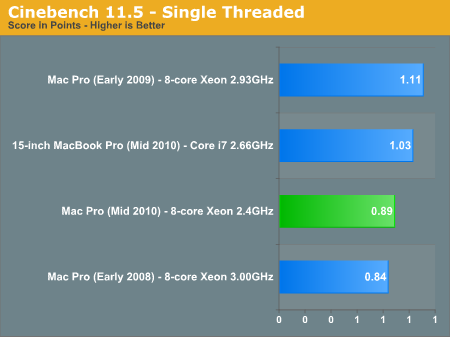
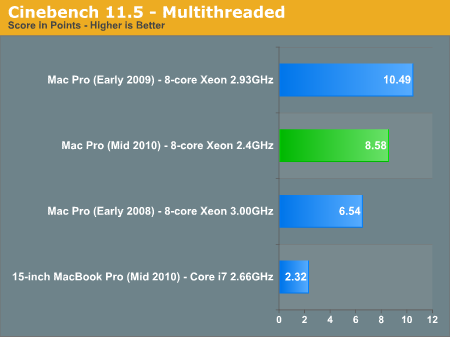
The newer benchmark is less bound by the performance of a single thread and thus we see it favoring the 2-threads-per-core you get from Nehalem/Westmere. In this case the 2.4GHz $3499 eight-core Mac Pro is faster than the 3.0GHz eight-core Mac Pro from 2008.
Remember that until Sandy Bridge, the L3 cache is the means of core-to-core communication in Intel’s Core series of processors. There was no single large shared cache in the 2006 - 2008 Mac Pro (each set of 2 cores shared an L2 cache) which is the reason for the relatively poor scaling there. Westmere gives you a larger L3 to play with and thus we see slightly better scaling from one to 16 threads vs. Nehalem. The size of the L3 cache in Westmere means that you can store more data shared by all of the cores in these heavily threaded applications.
Adobe Photoshop CS4 Performance
Photoshop is one of those benchmarks that really stresses everything. You get decent memory and I/O dependency and good use of multiple cores (but diminishing returns beyond 6 - 8 threads).
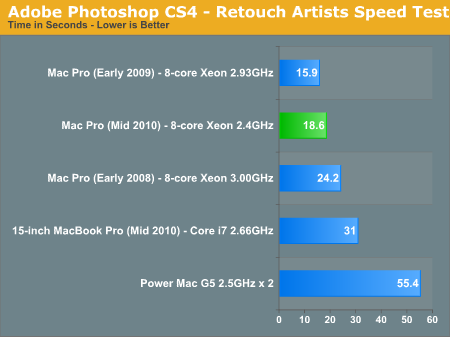
We’ve already shown the new Mac mini is nearly as fast as the Power Mac G5 in Photoshop, but the new Mac Pro cuts our test time in less than half compared to the old G5. The Westmere advantage is not tremendous here, some higher clocked Nehalems do better in this test.
Even the 2008 Mac Pro does well here, at least compared to the G5.
Aperture 2 RAW Import Performance
For my Aperture test I simply timed how long it took to import 203 12MP RAW images into the library.
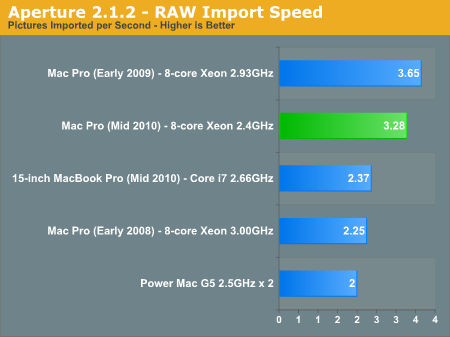
The 2009/2010 Mac Pros are very fast even in general use tasks like importing images into Aperture.
H.264 High Profile Transcoding
I have a feeling the transcoding game is going to get a lot more complicated after Sandy Bridge hits next year, but until then we’ve got our typical H.264 encoding tests. Here I’m taking a 90Mbps H.264 source file and transcoding it using Handbrake and the default High Profile settings.
The transcoding process peaks at about 11 threads, so there is an advantage to the Hyper Threading enabled systems but it’s not much. The sub-max thread count allows even the older 2008 Mac Pro to outpace the newcomer simply because of the system’s higher clocked CPUs in this case:
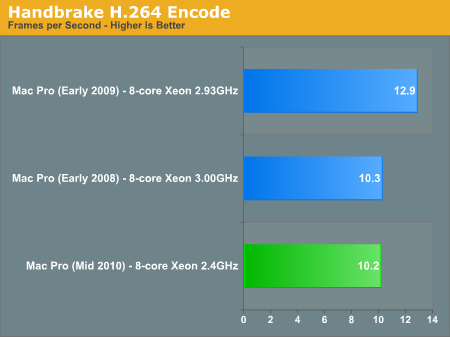
Clock for clock there is at least a 25% increase in performance over the old Mac Pro given the same number of cores. I wouldn’t expect a huge improvement vs. Nehalem at the same clock speed however.










84 Comments
View All Comments
mattgmann - Thursday, October 7, 2010 - link
I understand including a nice case, as the mac case is quality. But you're right, $250 is a bit steep. There are plenty of less expensive cases that are just as nice, and some real budget cases that would be serviceable.hellotyler - Thursday, October 7, 2010 - link
If I had the money, I'd buy one of these in a second. Apple rules. In today's world though, budget is important and PC beats out Apple heartily on the mid-powered PC market. I own both Mac and Pc (side by side, my two babies) and I love them both dearly. If I had to choose a brand new super powered computer though, I'd have to go with the Mac because of the OS.noiseunit - Thursday, October 7, 2010 - link
Maybe I'm missing something here but a quick search on newegg showed a $700 difference in the price of the graphics cards, maybe thats why the dell is so expensive?Stokestack - Tuesday, October 12, 2010 - link
The Mac IS a PC. If you mean a Windows system, then say that.ViperV990 - Thursday, October 7, 2010 - link
Didn't see it mentioned in the article, so I'm assuming no, but I want to double-check: Does the Mac Pro support 3x1 Eyefinity setup?Also, it's a shame that they're not offering the Eyefinity 5 or 6 models as an option.
Porksmuggler - Thursday, October 7, 2010 - link
Really appreciate the honest comparison to the custom built, but the Dell T5500 isn't exactly comparable. It's easy to say "other than the graphics card" but seriously:Apple's ATI Radeon HD 5770 1GB - $249 from Apple or $125 from Newegg
Dell's ATI FirePro V8700 1GB - $860 from Newegg
Anand Lal Shimpi - Thursday, October 7, 2010 - link
It's a tough comparison to make if you really want to dive into it. The FirePro price premium is due largely to the driver work and it's tough to tell what equivalent driver work (if any) Apple has done in OS X. Either way, it does change things quite a bit and I've updated the text to reflect that there is an Apple tax that's just hidden by the GPU cost differential.Thanks for the comment :)
Take care,
Anand
Porksmuggler - Thursday, October 7, 2010 - link
Thanks for the update, it truly is a tough comparison.I think an even greater concern with both the Dell and Apple tax is that both are using what might be considered as "commodity components"; Apple certainly would be using Foxconn, and I do not know of Dell's core supplier. The point being, these components do not have the same reputation of quality and performance as those used in the custom built.
The extent of the tax goes even further...
Sunburn74 - Thursday, October 7, 2010 - link
Not sure how you managed to reach the $324 number you published in the edit in the article. The cheapest fireprov8700 I can find costs 600 flat (ebay buy it now). The difference is at least $500 once you deduct the street costs of the packaged gpu.jecs - Thursday, October 7, 2010 - link
To me the "why a Mac Pro" is I have been afraid to build myself a solid dual socket PC workstation class machine for Pro 3D modeling, rendering and compositing with Maya and Final Cut Pro. But now I am very used to some pro Apple and none Apple software and happy. So in my case my current 2.8 octacore has been very, very reliable. For graphic design I agree it gets more difficult every time to justify a dual socket machine like a Mac Pro. Why 8-12 core for illustrator or even Photoshop?, Get the fastest quadcore PC for this. But also is a matter of personal preference.The Mac Pro is not the fastest machine out there but not either the most expensive or exotic hardware as there are usually faster PC hardware and more specific software options and features. But, if you like me are using specific multithreaded Pro software with decent performance and like OSX, then the Mac Pro is very solid. No Mac Pro has died on me yet, they are easy to upgrade for the most common features, work very well out of the box, is reliable, offers dual socket options and no Apple tax on comparable Dell or similar workstations.
On the other hand, even I use the Mac Pro all day long I builded a SFF quad core PC and this is the machine I am going to upgrade this year. The PC is "my back up" machine but the one that goes outside with me when I need performance, and also one very useful rendering machine.
By the way Anand, very good article! I enjoyed very much reading through the lines, not defensive at all, not too long and I learned on some features and coments. At least to my experience as a Mac Pro user from the beginning and even from the days of the G5s.